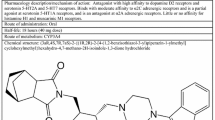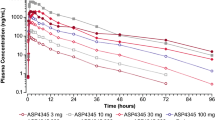Abstract
Purpose. To study the pharmacokinetics (PK) and pharmacodynamics (PD) of an investigational antipsychotic agent, CI-1007, in rats and monkeys.
Methods. CI-1007 and a pharmacologically active metabolite, PD 147693 (Ml), were evaluated in animal antipsychotic tests (inhibition of dopamine neuron firing and spontaneous locomotor activity in rats, and inhibition of continuous avoidance in monkeys). Plasma concentrations of CI-1007 and Ml were determined using validated HPLC assays. Log-linear and link models were used for PK/PD analysis.
Results. CI-1007 and Ml have shown similar effects on dopamine neuron firing (2.5 mg/kg i.p.), and produced dose-related effects on spontaneous locomotor activity in rats (0.3−30 mg/kg, p.o.) and on continuous avoidance in monkeys (0.6−1.2 mg/kg p.o.). After pharmacologically active CI-1007 doses, mean plasma CI-1007 Cmax increased from 19 to 200 ng/ml in Sprague-Dawley rats at doses of 3−30 mg/ kg, and from 8.1 to 34 ng/ml in squirrel monkeys at doses of 0.6−1.2 mg/kg, but corresponding plasma M1 Cmax values were near or below the limit of quantitation (5 ng/ml). CI-1007 EC50 was 31.1 ng/ml in rats, calculated from a log-linear regression. In monkeys, CI-1007 ECe50, γ, and Keo at 0.6 and 1.2 mg/kg were 4.8 and 4.5 ng/ml, 1.9 and 2.0, and 0.47 and 0.48 hr−1, respectively, calculated by the link model.
Conclusions. CI-1007 has shown dose-related pharmacokinetics and pharmacodynamics in rats and monkeys. Although Ml produces anti-psychotic-like effects similar to CI-1007, the contribution of Ml to the activity of the parent drug may not be significant in rats and monkeys as based on plasma levels. CI-1007 plasma concentration correlates log-linearly with inhibition effect from the rat locomotor study. The counter-clockwise hysteresis relationship of CI-1007 plasma concentration and inhibition effect from the monkey avoidance test was described by a link model, and the resulting Ce (concentration in effect compartment) versus effect profile exhibits a sigmoidal curve.
Similar content being viewed by others
REFERENCES
T. Pugsley, D. Davis, C. Akunne, L. Cooke, S. Whetzel, R. Mackenzie, Y. Shih, D. Van Leeuwen, L. Demattos, B. Caprathe, J. Wright, J. Jean, L. Wise, and T. Heffner. J. Pharmacol. Exp. Ther. 274:898–911 (1995).
L. Meltzer, C. Christoffersen, A. Corbin, F. Ninteman, K. Serpa, J. N. Wiley, L. Wise, and T. Heffner. J. Pharmacol. Exp. Ther. 274:912–920 (1995).
M. Rose Feng, C. Strenkoski, T. Parker, and D. S. Wright. Pharm Res. 10:S-320 (1993).
M. Rose Feng, S. Bezek, A. Gandhi, C. Strenkoski, T. Woolf, and D. S. Wright. Pharm Res. 10:S-347 (1994).
J. Wright, D. Downing, M. Rose Feng, R. Hayes, T. Heffner, R. Mackenzie, L. Meltzer, T. Pugsley, and L. Wise. J. Med. Chem. 38:5007–5014, (1995).
T. Heffner, D. Downs, L. Meltzer, J. Wiley, and A. Williams. J. Pharmacol. Exp. Ther. 251:105–112 (1989).
M. Rose Feng, P. Siersma, C. Strenkoski, and D. S. Wright. J. Chromatogr. B. 665:193–199 (1995).
L. Sheiner, D. Stanski, S. Vozeh, R. Miller, and J. Ham. Clin. Pharmacol Ther 3:358–371 (1979).
D. Verotta and L. Sheiner. J. Pharmacokin Biopharm 23(1):1–4 (1995).
M. Rose Feng, W. Mcnally, and L. Meltzer, unpublished data.
C. Walker. Drug metab Rev. 2:295–323, (1978).
M. Sinz, B. Michniewicz, and T. Woolf. Metabolic and species comparison of the antipsychotic agent CI-1007 using microsomes, hepatocyte, and purified enzymes. Poster for 4th International ISSX, Seattle, WA, 1995.
Wagner J (1993) Pharmacokinetics for the pharmaceutical scientist, Technomic, Lancaster—Basel.
J. Javaid. J. Clin. Pharmacol. 34:286–295 (1994).
A. Jørgensen. In J. W. Bridges and L. F. Chasseaud (eds.), Progress in Drug Metabolism. Taylor & Francis Ltd, 1986, Vol. 9, p 111–173.
W. Meuldermans, J. Hendrick, G. Mannen, K. Lavrijsen, C. Janssen, J. Bracke, L. Jeune, W. Lauwers, and J. Heykans. Drug Met. Dispos. 1:129–138 (1994).
O. Őgren, J. Laudstrőm, and B. Nilsson. J. Neural Transm. 94:199–216 (1993).
Stephen R. Marder, John M. Davis, Philip G. Janicak. Clinical use of neuroleptic plasma levels. American Psychiatric Press, Inc, Washington DC, 1993.
P. Snoeck, A. Peer, M. Horton, G. Mannens, R. Woestenborghs, R., Meibach, J. Heykants. Psychopharmacology 122:223–229 (1995).
Author information
Authors and Affiliations
Corresponding author
Rights and permissions
About this article
Cite this article
Feng, M.R., Corbin, A.E., Wang, Y. et al. Pharmacokinetics and Pharmacodynamics of an Investigational Antipsychotic Agent, CI-1007, in Rats and Monkeys. Pharm Res 14, 329–336 (1997). https://doi.org/10.1023/A:1012050121937
Issue Date:
DOI: https://doi.org/10.1023/A:1012050121937




